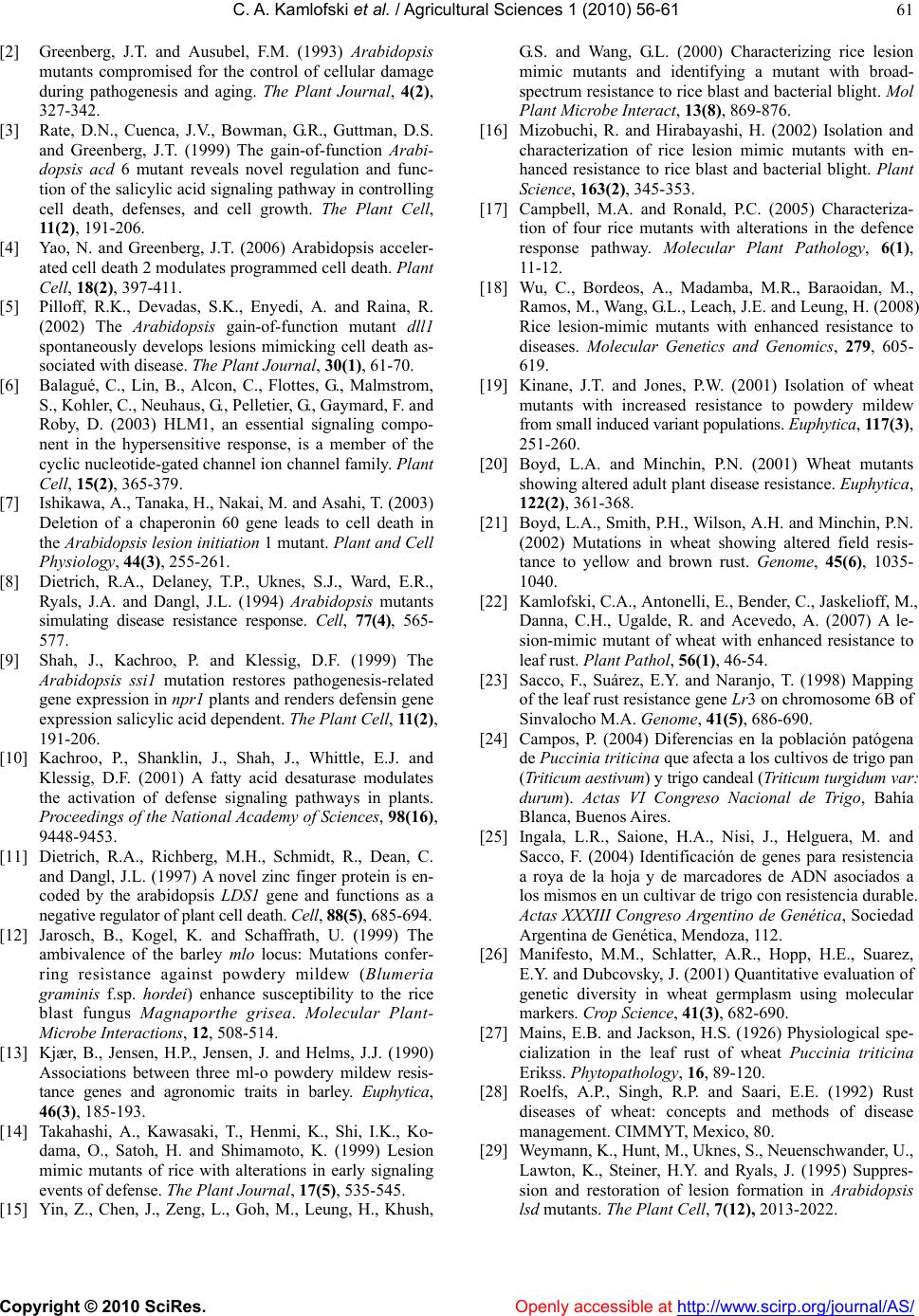
C. A. Kamlofski et al. / Agricultural Sciences 1 (2010) 56-61
Copyright © 2010 SciRes. http://www.scirp.org/journal/AS/Openly accessible at
61
[2] Greenberg, J.T. and Ausubel, F.M. (1993) Arabidopsis
mutants compromised for the control of cellular damage
during pathogenesis and aging. The Plant Journal, 4(2),
327-342.
[3] Rate, D.N., Cuenca, J.V., Bowman, G.R., Guttman, D.S.
and Greenberg, J.T. (1999) The gain-of-function Arabi-
dopsis acd 6 mutant reveals novel regulation and func-
tion of the salicylic acid signaling pathway in controlling
cell death, defenses, and cell growth. The Plant Cell,
11(2), 191-206.
[4] Yao, N. and Greenberg, J.T. (2006) Arabidopsis acceler-
ated cell death 2 modulates programmed cell death. Plant
Cell, 18(2), 397-411.
[5] Pilloff, R.K., Devadas, S.K., Enyedi, A. and Raina, R.
(2002) The Arabidopsis gain-of-function mutant dll1
spontaneously develops lesions mimicking cell death as-
sociated with disease. The Plant Journal, 30(1), 61-70.
[6] Balagué, C., Lin, B., Alcon, C., Flottes, G., Malmstrom,
S., Kohler, C., Neuhaus, G., Pelletier, G., Gaymard, F. and
Roby, D. (2003) HLM1, an essential signaling compo-
nent in the hypersensitive response, is a member of the
cyclic nucleotide-gated channel ion channel family. Plant
Cell, 15(2), 365-379.
[7] Ishikawa, A., Tanaka, H., Nakai, M. and Asahi, T. (2003)
Deletion of a chaperonin 60 gene leads to cell death in
the Arabidopsis lesion initiation 1 mutant. Plant and Cell
Physiology, 44(3), 255-261.
[8] Dietrich, R.A., Delaney, T.P., Uknes, S.J., Ward, E.R.,
Ryals, J.A. and Dangl, J.L. (1994) Arabidopsis mutants
simulating disease resistance response. Cell, 77(4), 565-
577.
[9] Shah, J., Kachroo, P. and Klessig, D.F. (1999) The
Arabidopsis ssi1 mutation restores pathogenesis-related
gene expression in npr1 plants and renders defensin gene
expression salicylic acid dependent. The Plant Cell, 11(2),
191-206.
[10] Kachroo, P., Shanklin, J., Shah, J., Whittle, E.J. and
Klessig, D.F. (2001) A fatty acid desaturase modulates
the activation of defense signaling pathways in plants.
Proceedings of the National Academy of Sciences, 98(16),
9448-9453.
[11] Dietrich, R.A., Richberg, M.H., Schmidt, R., Dean, C.
and Dangl, J.L. (1997) A novel zinc finger protein is en-
coded by the arabidopsis LDS1 gene and functions as a
negative regulator of plant cell death. Cell, 88(5), 685-694.
[12] Jarosch, B., Kogel, K. and Schaffrath, U. (1999) The
ambivalence of the barley mlo locus: Mutations confer-
ring resistance against powdery mildew (Blumeria
graminis f.sp. hordei) enhance susceptibility to the rice
blast fungus Magnaporthe grisea. Molecular Plant-
Microbe Interactions, 12, 508-514.
[13] Kjær, B., Jensen, H.P., Jensen, J. and Helms, J.J. (1990)
Associations between three ml-o powdery mildew resis-
tance genes and agronomic traits in barley. Euphytica,
46(3), 185-193.
[14] Takahashi, A., Kawasaki, T., Henmi, K., Shi, I.K., Ko-
dama, O., Satoh, H. and Shimamoto, K. (1999) Lesion
mimic mutants of rice with alterations in early signaling
events of defense. The Plant Journal, 17(5), 535-545.
[15] Yin, Z., Chen, J., Zeng, L., Goh, M., Leung, H., Khush,
G.S. and Wang, G.L. (2000) Characterizing rice lesion
mimic mutants and identifying a mutant with broad-
spectrum resistance to rice blast and bacterial blight. Mol
Plant Microbe Interact, 13(8), 869-876.
[16] Mizobuchi, R. and Hirabayashi, H. (2002) Isolation and
characterization of rice lesion mimic mutants with en-
hanced resistance to rice blast and bacterial blight. Plant
Science, 163(2), 345-353.
[17] Campbell, M.A. and Ronald, P.C. (2005) Characteriza-
tion of four rice mutants with alterations in the defence
response pathway. Molecular Plant Pathology, 6(1),
11-12.
[18] Wu, C., Bordeos, A., Madamba, M.R., Baraoidan, M.,
Ramos, M., Wang, G.L., Leach, J.E. and Leung, H. (2008)
Rice lesion-mimic mutants with enhanced resistance to
diseases. Molecular Genetics and Genomics, 279, 605-
619.
[19] Kinane, J.T. and Jones, P.W. (2001) Isolation of wheat
mutants with increased resistance to powdery mildew
from small induced variant populations. Euphytica, 117(3),
251-260.
[20] Boyd, L.A. and Minchin, P.N. (2001) Wheat mutants
showing altered adult plant disease resistance. Euphytica,
122(2), 361-368.
[21] Boyd, L.A., Smith, P.H., Wilson, A.H. and Minchin, P.N.
(2002) Mutations in wheat showing altered field resis-
tance to yellow and brown rust. Genome, 45(6), 1035-
1040.
[22] Kamlofski, C.A., Antonelli, E., Bender, C., Jaskelioff, M.,
Danna, C.H., Ugalde, R. and Acevedo, A. (2007) A le-
sion-mimic mutant of wheat with enhanced resistance to
leaf rust. Plant Pathol, 56(1), 46-54.
[23] Sacco, F., Suárez, E.Y. and Naranjo, T. (1998) Mapping
of the leaf rust resistance gene Lr3 on chromosome 6B of
Sinvalocho M.A. Genome, 41(5), 686-690.
[24] Campos, P. (2004) Diferencias en la población patógena
de Puccinia triticina que afecta a los cultivos de trigo pan
(Triticum aestivum) y trigo candeal (Triticum turgidu m v a r:
durum). Actas VI Congreso Nacional de Trigo, Bahía
Blanca, Buenos Aires.
[25] Ingala, L.R., Saione, H.A., Nisi, J., Helguera, M. and
Sacco, F. (2004) Identificación de genes para resistencia
a roya de la hoja y de marcadores de ADN asociados a
los mismos en un cultivar de trigo con resistencia durable.
Actas XXXIII Congreso Argentino de Genética, Sociedad
Argentina de Genética, Mendoza, 112.
[26] Manifesto, M.M., Schlatter, A.R., Hopp, H.E., Suarez,
E.Y. and Dubcovsky, J. (2001) Quantitative evaluation of
genetic diversity in wheat germplasm using molecular
markers. Crop Science, 41(3), 682-690.
[27] Mains, E.B. and Jackson, H.S. (1926) Physiological spe-
cialization in the leaf rust of wheat Puccinia triticina
Erikss. Phytopathology, 16, 89-120.
[28] Roelfs, A.P., Singh, R.P. and Saari, E.E. (1992) Rust
diseases of wheat: concepts and methods of disease
management. CIMMYT, Mexico, 80.
[29] Weymann, K., Hunt, M., Uknes, S., Neuenschwander, U.,
Lawton, K., Steiner, H.Y. and Ryals, J. (1995) Suppres-
sion and restoration of lesion formation in Arabidopsis
lsd mutants. The Plant Cell, 7(12), 2013-2022.